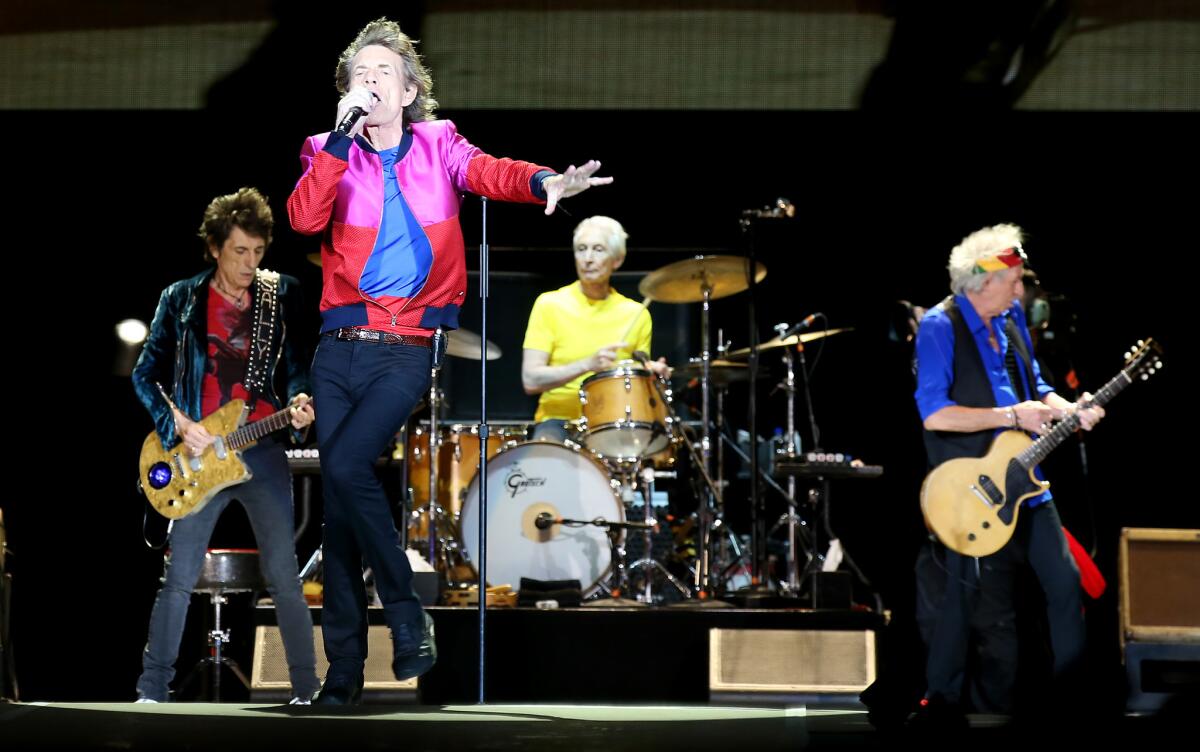The Rolling Stones go home to the blues with ‘Blue & Lonesome’

- Share via
When the Rolling Stones fell in love with American blues music as teenagers in England in the late 1950s and early ’60s, the grand old men of the genre they idolized were 20 to 30 years their seniors.
Muddy Waters was in his late 40s and Howlin’ Wolf was about 50.
Now that the Stones themselves are wizened veterans, they are bringing a lifetime’s worth of experience to bear in their homage to their youthful heroes in “Blue & Lonesome,” the first full-fledged blues outing ever for the group often called “The World’s Greatest Rock & Roll Band.”
And to hear Mick Jagger and Keith Richards talk about it, you get the impression it feels to them like the difference between then and now is barely the blink of an eye.
See the most-read stories in Entertainment this hour »
“In a way it reminds me of 1962,” Richards, 72, said in an interview from his home in Connecticut.
“On the other hand, we probably play them a little different now, probably with more confidence,” he said. “We have the sound down better now. When we started in England, there wasn’t anybody who knew how to record this stuff, so that took quite a while to organize. It was only when we came to America and got into American studios that we really started to hit our stride.”
Added Jagger, 73, in a separate interview from London ahead of the album’s Friday release, “The hopeful thing, the surprising thing is that it still retains that enthusiasm — that’s the thing that’s the same, the enthusiasm you’ve got for the music.”
The dozen tracks that make up “Blue & Lonesome” were recorded relatively quickly over three days last December in London. Early reviews have been enthusiastic. They point to the lived-in authenticity the Stones invest in the songs, and the appropriately gritty, down-and-dirty sound created by Jagger, Richards, drummer Charlie Watts and guitarist Ron Wood with the help of longtime Stones producer Don Was.
The album is one key element of a particularly busy fall for the group.
Along with the Stones’ back-to-back weekend performances in October for the Desert Trip classic rock superstar blowout in Indio, there was also the U.S. opening on Nov. 12 of “Exhibitionism,” a major exploration in New York of the band’s 50-plus year career, as well as the home video release of the “Havana Moon” album and DVD documenting the group’s massive free show in Cuba in March.
“Blue & Lonesome” grew out of the band’s habit of warming up by running through the songs they’d loved as aspiring musicians, when they were lapping up every lick of Southern-drenched, Chicago-incubated blues they could get their hands on across the Atlantic Ocean.
Indeed, the band’s formation story is now part of rock legend. Richards first made contact with Jagger when he spotted the future lead singer in a train station carrying albums by Muddy Waters and Chuck Berry. Suddenly, Richards found himself a comrade in American roots music.
“I threw the idea around the last couple of years with Don Was,” Jagger said. “Every time we rehearse we always do some blues songs, and I thought we should record them, then put out an album. When you’re rehearsing you tend to be relatively relaxed. You don’t have any pressure, so sometimes these things sound really good, because there are no engineers saying ‘Let’s try another take.’ You just do it.
“I don’t think it was on the menu of anyone,” he said. “It was completely out of the blue, and so we just picked up and it sounded good. The first one sounded good, and then the second one sounded good, and pretty soon I thought, ‘I see what’s going on here.’ The thing is, you get kind of lucky sometimes, and when you’re in that lucky space, you just want to stay there.”
Instead of simply using the blues numbers as musical muscle flexing, they devoted their full attention to seriously digging in for three days. Jagger took it on himself to compile lists of songs to consider, which he said were offered up as the sessions unfolded. If someone objected, he said, he’d just move on to the next song on the list until consensus was reached.
“Obviously I feel completely different than I did then,” he said. “But in a way it’s still the same thing. I don’t think you can think about your life experience while you’re doing it. You’re just doing the tune. I’m just being an interpretive singer — that’s my gig. So when we say ‘OK, we’re going to do [Little Walter’s] ‘Just Your Fool,’ I’m just trying to interpret it as well as I can.”
The focus is by and large on Chicago blues, and on songs recorded by artists signed to the Chess and Checker labels of pioneering blues record execs Leonard and Phil Chess. Four are associated with harmonica player Little Walter [Jacobs], two with bassist-songwriter-producer Willie Dixon and the rest with the likes of Howlin’ Wolf, Lightnin’ Slim, Jimmy Reed, Magic Sam and, the most recent, “Everybody Knows About My Good Thing,” originally recorded in 1971 by Little Johnny Taylor.
One of the realizations out of the experience, Richards said, “It’s the recall on everything we did. It was automatically there, you didn’t have to do any memory searching, it just sort of flowered, and I just let it roll. Mick’s playing great harp and doing great vocals. The arrangements stuck pretty close to the originals. It just arrived, there was no planning — we just kicked it off and got into it.”
Richards is famous for saying it’s the roll in rock ’n’ roll that’s more important than the rock. The same appears to hold true in the Stones’ approach to the blues. “There’s a lot of roll on this — thanks to Charlie Watts and Darryl Jones, who played lovely bass on this. I love my rhythm section.”
The sessions allowed Jagger to immerse himself in playing blues harp.
“Playing for three days in a row — that’s not what I normally do,” he said. “You get more confident with it, and in a studio, you can really hear what you’re doing. When you play harmonica with a rock band on a stage, it’s hard to hear the nuances” he said with a laugh. “That’s an instrument that you need to actually hear what you’re doing. You can’t see the keys, and you have to bend the notes to get the notes you’re trying to get. If you can’t hear it, you really don’t know if you’re hitting it.”
Likewise, he felt liberated in his singing by the concentrated time with the vintage songs. “There are things I can attempt now that I wouldn’t have attempted before. It’s all the blues, but there are a lot of different styles. Compare [Lightnin’ Slim’s] ‘Hoodoo Man Blues’ to [Otis Rush’s] ‘I Can’t Quit You Baby,’ they are totally different vocal stylings.”
If there’s a common thread for Jagger, it was the effort to bring a sonic unity to the varied vocal expressions, instrumental combinations, rhythmic grooves and lyrical narratives of the songs.
“The whole thing about this particular kind of record was trying to get as cohesive a sound on everything — where you’re not picking out any star performances, in a way,” he said.
“That’s the essence of some of those Chess songs,” he added. “You can make counter-arguments — that Hubert Sumlin jumps out of some of those Howlin’ Wolf records. But on a lot of them you can’t discern who’s playing what or what kind of instrument it is until you really listen.
“My thinking on the mixing of it was to re-create some of those things,” he said. “You’re hearing the sound of a band; sometimes you can’t figure out if it’s Keith or Ron who’s playing the solo, or who’s playing the rhythm part. It’s not a wide stereo — it’s a very narrow stereo, and with the amount of distortion it sounds like this one ball of fire.”
Follow @RandyLewis2 on Twitter.com
For Classic Rock coverage, join us on Facebook
ALSO
At Desert Trip, the Rolling Stones gather no moss
Neil Young is out to reinvent the live album on ‘Earth’
What did Leonard Cohen really mean when he sang ‘Hallelujah’?
More to Read
The biggest entertainment stories
Get our big stories about Hollywood, film, television, music, arts, culture and more right in your inbox as soon as they publish.
You may occasionally receive promotional content from the Los Angeles Times.










